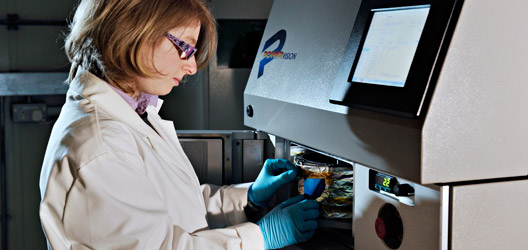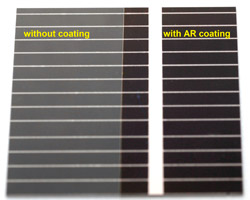Latest news from Loughborough University

14 Apr 2014
Loughborough scientists come up with method of reducing solar panel glare
 Picture 1: A comparison of the reflection from a cover glass on a crystalline Silicon cell with and without the multilayer AR coating.
Picture 1: A comparison of the reflection from a cover glass on a crystalline Silicon cell with and without the multilayer AR coating.
The glare from solar farms could be a thing of the past, thanks to scientists at Loughborough University.
Researchers have developed a multi-layer anti-reflection (AR) coating for glass surfaces, which reduces the sun’s reflection from photovoltaic panels while at the same time improving their efficiency.
The coating was developed by researchers at the Centre for Renewable Energy Systems Technology (CREST) who believe it will be attractive to solar panel manufacturers.
It is applied using the same technology as that used for depositing anti-reflection coatings on spectacles.
Professor Michael Walls, one of three CREST members who came up with the multi-layer AR design, said: “We really want to see these AR coatings implemented by manufacturers.
“They improve the module power output by about four per cent and will be low cost if manufactured in high volume.
“It’s a great added value proposition for float glass manufacturers.”
Each glass surface reflects about four per cent of the incident light, representing a significant loss of light into the module.
The AR design, developed by Professor Walls, Dr Piotr Kaminski and Fabiana Lisco, reduces the reflection by more than 70 per cent across the wavelength range accepted by PV panels.
The effectiveness of the coating is demonstrated in Picture 1 where a glass cover sheet has been placed above a crystalline silicon PV cell.
The area covered by the AR coated glass is clearly visible whereas the part of the cell covered with non-coated glass is obscured by reflections.
The design consists of only four alternate layers of zirconium oxide and silicon dioxide and the whole stack is less than 300 nanometres thick.
These materials were chosen because they are abundant and low cost.
Dr Kaminski said: “The AR coating has to be cost effective and so the design is a compromise. We want the best quality AR coating but with inexpensive materials and as few layers as possible. Also, the whole stack should be very thin to save time in manufacturing.”
The coatings are deposited using magnetron sputtering by a machine developed by UK based Power Vision Ltd to deposit AR coatings on spectacle lenses.
Although the work is specifically aimed at the improvement in efficiency of thin film Cadmium Telluride solar cell devices, the coatings can be applied to other thin film technologies such as CIGS (copper indium gallium selenide) and amorphous silicon.
They can also be applied to cover glass on crystalline silicon modules and even third generation devices such as organic or perovskite devices.
Dr Kaminski said: “Each PV technology operates in a different wavelength range and it is relatively simple to accommodate this in the multilayer design for each case”.
Magnetron sputtering is an easily scaleable technology already used by glass manufacturers for other types of coatings.
The materials are scratch resistant and very durable and would be effective for the full 25 year warranty offered by PV module manufacturers.
The work was funded by the Engineering and Physical Sciences (EPSRC) Supergen SuperSolar Hub.
Notes for editors
Article reference number: PR 14/72
About EPSRC
The Engineering and Physical Sciences Research Council (EPSRC) is the UK’s main agency for funding research in engineering and the physical sciences. EPSRC invests around £800 million a year in research and postgraduate training, to help the nation handle the next generation of technological change. The areas covered range from information technology to structural engineering, and mathematics to materials science. This research forms the basis for future economic development in the UK and improvements for everyone’s health, lifestyle and culture. EPSRC works alongside other Research Councils with responsibility for other areas of research. The Research Councils work collectively on issues of common concern via Research Councils UK. www.epsrc.ac.uk
About Loughborough University
Loughborough is one of the country’s leading universities, with an international reputation for research that matters, excellence in teaching, strong links with industry, and unrivalled achievement in sport and its underpinning academic disciplines.
It was awarded the coveted Sunday Times University of the Year title in 2008-09 and has been named Sports University of the Year 2013-14 by The Times and Sunday Times. Loughborough is consistently ranked in the top twenty of UK universities in the Times Higher Education’s ‘table of tables’ and has been voted England's Best Student Experience for six years running in the Times Higher Education league. In recognition of its contribution to the sector, Loughborough has been awarded seven Queen's Anniversary Prizes.
In 2015 the University will open an additional academic campus in London’s new innovation quarter. Loughborough University in London, based on the Queen Elizabeth Olympic Park, will offer postgraduate and executive-level education, as well as research and enterprise opportunities.
Contact for all media enquiries
Chris Goddard
Public Relations Officer
Loughborough University
T: 01509 228697
E: C.J.Goddard@lboro.ac.uk